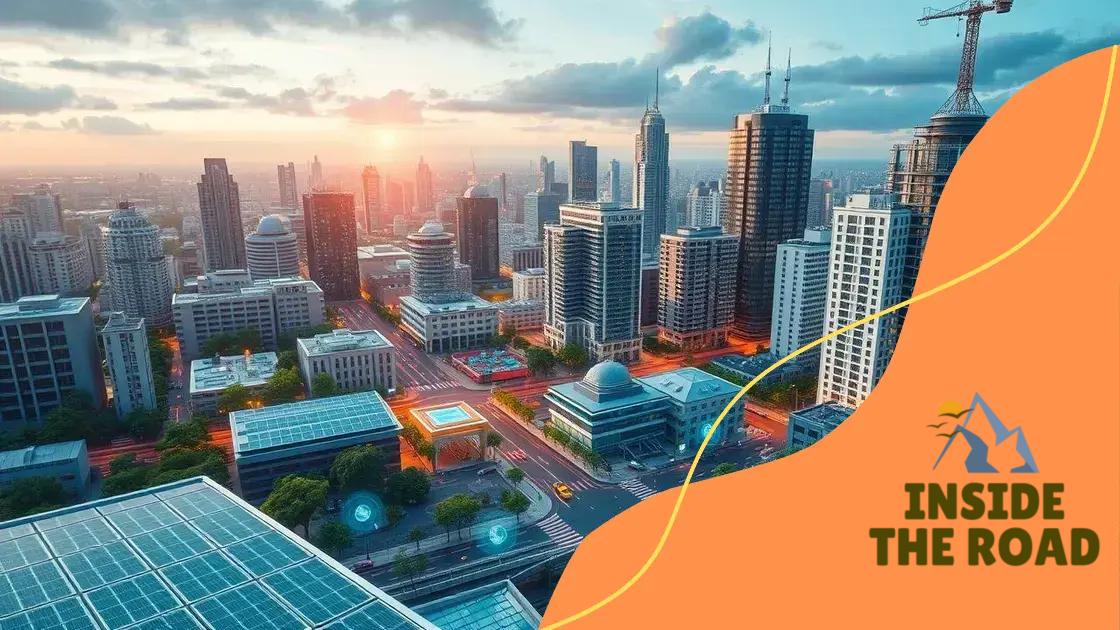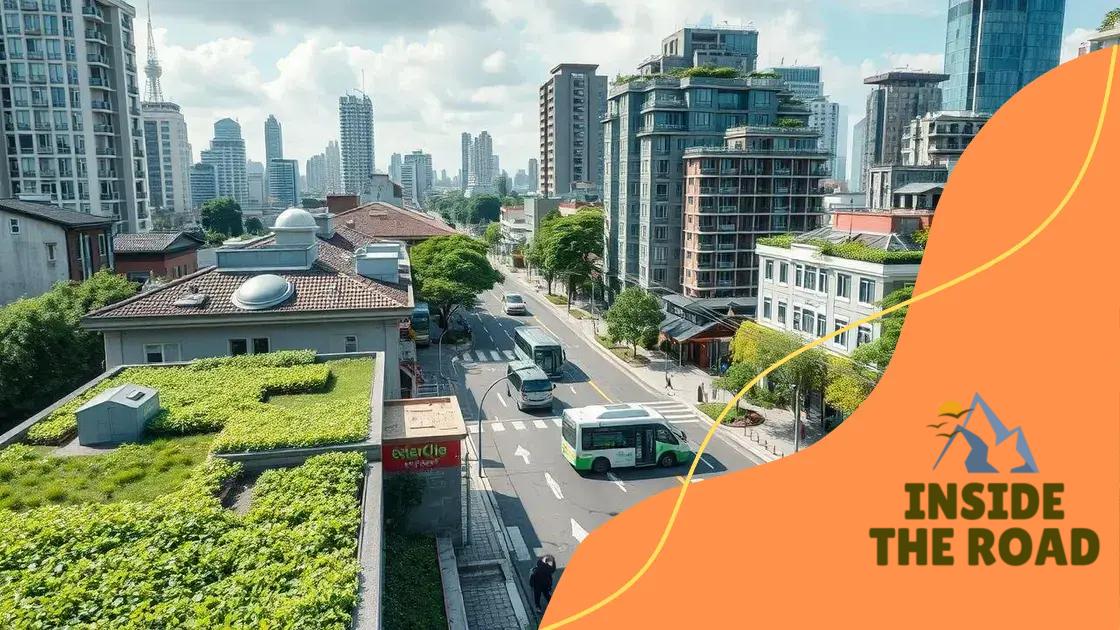Smart cities and their role in urban sustainability

Smart cities leverage technology to enhance urban sustainability by optimizing resource management, reducing waste, and fostering community engagement, ultimately improving quality of life while addressing environmental concerns.
Smart cities and their role in urban sustainability is a fascinating topic that affects how we live and interact with our environment. Have you noticed how technology is transforming urban landscapes? In this article, we’ll dive into what makes a city ‘smart’ and explore its impacts on sustainability.
Understanding the concept of smart cities
Understanding the concept of smart cities is essential as urban areas continue to evolve. These cities use technology to improve the quality of life for their residents and enhance environmental sustainability. As cities grow, traditional infrastructures struggle to keep up. That’s where the idea of a smart city comes into play.
What Makes a City Smart?
A smart city integrates digital technology into every aspect of its functions. This can include energy management, transportation systems, and waste reduction. By connecting various systems, smart cities can operate more efficiently. For example, smart traffic lights adjust in real-time to reduce congestion, saving time and energy.
- Enhanced public transportation through real-time data.
- Improved energy efficiency with smart grids.
- Increased public safety with connected surveillance systems.
- Greener waste disposal methods using smart bins.
The flow of data in a smart city allows for better decision-making. Residents can access information about their city’s services through mobile apps, which makes life easier and promotes civic engagement. Additionally, the focus on sustainability means that smart cities prioritize green spaces and renewable energy.
The Role of Technology
Technology plays a significant role in making cities smarter. IoT (Internet of Things) devices, sensors, and analytics help to collect data. This data is then analyzed to identify trends and improve city services. For instance, smart water management systems reduce waste by monitoring usage in real time. Moreover, the integration of artificial intelligence enables cities to predict problems before they arise, creating proactive solutions.
Smart cities also lead to economic growth. By attracting tech companies and fostering innovation, they create new job opportunities. This economic boost benefits residents and can improve overall community well-being by providing better public services and amenities.
Key technologies driving smart urban solutions
Key technologies driving smart urban solutions are transforming how cities function. These technologies enhance services, improve the quality of life, and promote sustainability. Understanding these technologies helps us see the future of urban living.
Internet of Things (IoT)
The Internet of Things is crucial for smart cities. It connects devices and systems, allowing them to communicate. For instance, smart sensors can monitor air quality or traffic patterns, providing valuable data to city planners.
- Smart traffic lights that adjust based on real-time conditions.
- Waste management systems that optimize collection routes.
- Water sensors that detect leaks, saving resources.
- Connected public transport systems with real-time tracking.
Artificial intelligence also plays a significant role. AI analyzes vast amounts of data to identify trends that help with decision-making. By using predictive analytics, cities can anticipate needs and allocate resources effectively. For example, AI can optimize energy usage in buildings, reducing costs and minimizing environmental impact.
Big Data and Analytics
Big data refers to the large volumes of data collected from various sources. Cities use analytics tools to interpret this data. This process helps in making informed decisions, such as improving public safety or enhancing services. By analyzing resident feedback and patterns, cities can adapt to meet the communities’ needs.
Moreover, advanced telecommunications technology ensures that information flows seamlessly. High-speed internet and 5G networks allow for quick data transfer between devices and systems, improving responsiveness. This responsiveness leads to better service delivery and enhanced citizen engagement.
Environmental benefits of smart city initiatives

The environmental benefits of smart city initiatives are substantial and contribute to creating sustainable urban spaces. These initiatives focus on reducing waste, conserving resources, and promoting greener living environments. Understanding these benefits can inspire cities to adopt smart solutions.
Reduction of Carbon Footprint
Smart cities actively work to reduce their carbon footprint by integrating green technologies. For example, cities implement smart grids that optimize energy use, reducing both emissions and costs. By using renewable energy sources, cities can significantly lower their reliance on fossil fuels.
- Smart energy management systems enable efficient energy distribution.
- Electric public transport reduces air pollution.
- Smart buildings use sensors to lower energy consumption.
- Tree planting initiatives supported by smart data enhance urban greenery.
Implementing eco-friendly practices is crucial. Through data collection and monitoring, cities can manage resources more sustainably. For instance, smart irrigation systems can adjust watering schedules based on weather forecasts, minimizing water waste and maintaining green spaces.
Waste Management Improvements
Another significant benefit is in waste management. Smart waste bins equipped with sensors notify city services when they are full. This helps optimize collection routes and reduces fuel consumption. By using advanced analytics, cities can predict waste generation patterns and adjust services accordingly.
This predictive approach not only saves money but also keeps streets cleaner. Additionally, waste recycling programs become more effective when supported by technology. Smart sorting systems increase recycling rates and decrease landfill usage, promoting a circular economy.
Finally, smart cities promote biodiversity by creating habitats within urban settings. Initiatives such as green roofs and vertical gardens contribute to healthier ecosystems. These measures improve air quality and mitigate heat effects in densely populated areas.
Challenges in implementing smart city projects
Challenges in implementing smart city projects can hinder progress and limit benefits. Although these initiatives promise significant improvements, cities often face obstacles that delay or complicate their execution. Understanding these challenges helps in overcoming them.
Funding and Budgeting
One major challenge is securing adequate funding. Many smart city projects require extensive investment in technology and infrastructure. Municipal budgets can be tight, making it difficult to allocate funds for such initiatives. Cities often look for grants or partnerships with private companies but may struggle to find the right resources.
- Limited budgets can delay project timelines.
- Uncertain return on investment can deter investors.
- Competition for public funds increases pressure on planning.
- Partnerships may complicate decision-making processes.
Additionally, miscommunication regarding costs and benefits can lead to misalignment between stakeholders. This misalignment often results in projects that do not fulfill community needs effectively.
Technological Integration
The integration of new technologies poses another significant hurdle. Cities rely on a variety of systems, many of which may be outdated. Upgrading these systems to support smart technology can be costly and time-consuming. Data interoperability is also a concern, as multiple platforms must communicate seamlessly.
Moreover, the rapid pace of technological change can make it difficult for cities to keep up. As new innovations emerge, some previously implemented systems might become obsolete, leading to wasted resources and frustration among users. Cities can benefit from creating a strategic technology roadmap to guide their investments and integrations.
Finally, achieving public buy-in is essential yet challenging. Residents must understand the benefits of smart initiatives for successful implementation. Public education and outreach are crucial to address concerns, foster trust, and encourage participation.
Future trends in urban sustainability with smart cities
Future trends in urban sustainability with smart cities promise exciting changes for how we live and interact with our environment. As technology evolves, cities are expected to adopt innovative solutions that enhance quality of life while protecting natural resources. This evolution will focus on integration, efficiency, and community involvement.
Enhanced Connectivity
In the future, connectivity will play a crucial role in smart cities. With advancements in 5G technology, faster internet speeds will enable seamless communication among devices. This connectivity will enhance services and improve daily living. Smart sensors will collect real-time data to help cities manage resources effectively.
- Improved traffic management through real-time data analysis.
- Interactive public transport systems that respond to user needs.
- Efficient energy distribution using smart grids.
- Enhanced emergency response systems through quick communication.
As cities leverage these technologies, residents can enjoy smoother transportation, better access to services, and a more responsive urban environment.
Green Infrastructure
Another key trend is the integration of green infrastructure. Cities will increasingly invest in parks, green roofs, and urban gardens to promote biodiversity and enhance air quality. These spaces will not only beautify urban areas but also improve mental well-being for residents. Smart city projects will focus on designing urban areas that balance nature and technology.
Moreover, the implementation of sustainable building practices will gain traction. New developments will prioritize energy efficiency and renewable energy installations. Features like solar panels and energy-efficient appliances will become standard in residential and commercial buildings.
Community engagement will also highlight future trends. As cities become smarter, involving residents in decision-making processes is vital. Public input will help shape urban policies, ensuring projects meet the specific needs of communities.
FAQ – Frequently Asked Questions about Smart Cities and Urban Sustainability
What are smart cities?
Smart cities use technology to improve the quality of life for residents, enhance urban services, and promote sustainability.
How do smart cities contribute to sustainability?
They utilize smart technologies to manage resources efficiently, reduce waste, lower emissions, and create greener urban spaces.
What role does community engagement play in smart cities?
Community engagement helps ensure that smart city projects meet the needs of residents, fostering support and collaboration in urban planning.
What challenges do cities face in becoming smart cities?
Cities often struggle with funding, integrating new technologies, managing existing infrastructure, and ensuring public acceptance.






